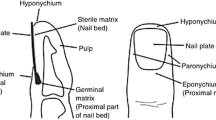Abstract
Background
Management of nail injuries can often be a challenging experience, especially in presence of complex fingertips’ injuries that include soft tissue loss and distal phalanx injury. Most studies found in the literature focus on individual injuries and describe methods to tackle those injuries, notwithstanding the fact that the nail, nailbed, distal phalanx, soft tissue and skin of the finger tip form a complex and often more than one element of this complex is injured. This retrospective study therefore focuses on the management of nail bed injuries as a part of the complex finger tip injury and outlines the surgical principles and techniques that were used in their management.
Materials and Methods
Two hundred and forty patients from a tertiary care center in different clinical settings where a wide variety of cases involving the nail bed injuries were included in this study. Patients comprised of 192 (80%) males and 48 (20%) females with the average male age of 37.3 years (range 1-66 years) and average female age of 29 years (range 1-59 years). 210 patients had single finger involment, 30 patients had two finger involvement (total fingers involved- 270). The middle finger was most commonly involved while the index finger was the second most commonest finger involved. In 198 (89.18%) patients local anaesthesia was used while in the rest: regional blocks [n = 10 (4.5%)] and general anaesthesia [n = 14 (6.3%)] were used.
Results
In this retrospective study, out of the total of two hundred and forty patients, 222 (92.5%) patients underwent surgery, while the rest 18 (7.5%) were treated conservatively. Two hundred and ten patients who underwent surgery had complete healing over the course of treatment and followup, while four patients needed secondary interventional. Eight patients who had surgery were migrant workers were lost to follow up after surgery. Eight patients had postoperative complications that included infection, secondary necrosis, wound breakdown and non healing fractures.
Conclusion
Accurate and timely diagnosis of nail bed injury and its meticulous repair is cardinal to the management of any nail bed injury. However all nail bed injuries must be seen in the context of associated injuries of the finger tip complex, namely skin, soft tissue and distal phalanx injuries. Fixation of associated bony injury which closely underlines the nail bed and provides physical support to the nail bed along with correction of soft tissue injuries in the form of flaps or grafts, compounded by the repair or replacement of nail plate in the first 24 hours.
Similar content being viewed by others
References
Bharathi RR, Bajantri B. Nail bed injuries and deformities of nail. Indian J Plast Surg 2011;44:197–202.
Pearce S, Colville RJ. Nailbed repair and patient satisfaction in children. Ann R Coll Surg Engl 2010;92:483–5.
Fairbairn N No such thing as "just" a nail bed injury. Pediatr Emerg Care 2012;28:363–5.
Strauss EJ, Weil WM, Jordan C, Paksima N. A prospective, randomized, controlled trial of 2–octylcyanoacrylate versus suture repair for nail bed injuries. J Hand Surg Am 2008;33:250–3.
Ogunro EO. External fixation of injured nail bed with the INRO surgical nail splint. J Hand Surg Am 1989; 14(2 Pt 1):236–41.
Bindra RR. Management of nail-bed fracture-lacerations using a tension-band suture. J Hand Surg Am 1996;21:1111–3.
Tos P, Titolo P, Chirila NL, Catalano F, Artiaco S. Surgical treatment of acute fingernail injuries. J Orthop Traumatol 2012;13:57–62.
Roser SE, Gellman H. Comparison of nail bed repair versus nail trephination for subungual hematomas in children. J Hand Surg Am 1999;24:1166–70.
Rosenthal EA. Treatment of fingertip and nail bed injuries. Orthop Clin North Am 1983;14:675–97.
Endo T, Nakayama Y. Micro transfers for nail and fingertip replacement. Hand Clin 2002;18:615–22.
Raja Sabapathy S, Venkatramani H, Bharathi R, Jayachandran S. Reconstruction of finger tip amputations with advancement flap and free nail bed graft. Hand Surg Br 2002;27:134–8.
Author information
Authors and Affiliations
Corresponding author
Additional information
This is an open access article distributed under the terms of the Creative Commons Attribution-NonCommercial-ShareAlike 3.0 License, which allows others to remix, tweak, and build upon the work non-commercially, as long as the author is credited and the new creations are licensed under the identical terms.
Rights and permissions
About this article
Cite this article
George, A., Alexander, R. & Manju, C. Management of Nail Bed Injuries Associated with Fingertip Injuries. IJOO 51, 709–713 (2017). https://doi.org/10.4103/ortho.IJOrtho_231_16
Published:
Issue Date:
DOI: https://doi.org/10.4103/ortho.IJOrtho_231_16




